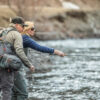Synopsis
As we head toward September, the regional fishing continues to be very good. Caddis and a variety of mayflies are present on the Big Wood in relatively strong numbers, the Trico spinner fall and associated insect activity highlights the action on Silver Creek and the Big Lost River level has continued to drop. Those who travel “over the hill” are finding fantastic fishing up in the alpine and the high mountain lakes, which remain as great respites from the sometimes crowded waters of the meandering river basins. All in all, it is an excellent time to be fly fishing in the central Rockies.
Big Wood River
The Wood, currently flowing at 235cfs, is providing local anglers with some very fine fishing…especially in the mornings and evenings. The caddis, which varies from a large (size 12) beige prairie-like caddis to smaller, brown microcaddis, is ubiquitous on the Big Wood. Emerging primarily at dusk, these moths are bringing fish to the surface, often aggressively. Accompanying these trout treats are a myriad of midges – although they are too small to simulate and the fish are not keying on them. As the morning presses on, a number of mayflies begin to appear ranging from the Baetis and Trico to the occasional PMD and even a flav? or two. Appearing like large Blue Winged Olives, if you are lucky enough to encounter these bugs on the stretch of river you are fishing, don’t hesitate to imitate and cast. At the same time, you’ll notice the solid populations of the small yellow cranefly. I am not speaking of the golf ball sized “Mosquito Eater” that seems as large as a hummingbird, but rather its daintier cousin. Around midday, look for the smaller Pink Alberts which will dot the river’s surface (size 16s and 18s). Afternoons generally revolve around grasshoppers of all sizes with mayfly nymphs and caddis pupae dropped below. Evenings are essentially a caddis factory with many of these large and small insects bringing the more cautious fish to the surface.
Silver Creek
The Creek is at its August prime with Tricos filling the air as the day temperature approaches 70 degrees. Using duns as the action begins is a good idea while watching closely as the abundance of mayflies give into the lethal price of mating and lay their wings out for good. These spinners then become the focus of ravenous risers as this fine spring creek really turns on. Baetis will begin to emerge in abundance soon afterward and including a Baetis dun or two in your fly rotation is an excellent way of catching fish off guard. PMDs will appear, sometimes in large numbers, before falling to the surface spinner-style. Look for the more aggressive rises to clue you in to this temporary fish focus. As the morning action subsides, shift your fly selection to the larger terrestrials such as grasshoppers and beetles and of course the beautiful blue damsel flies. The mating damsel pattern can be just the meal our midday rainbows or browns desire. Callibaetis are also present during the midday hours (morning too). Generally you will see Callibaetis spinners drifting lifelessly down through slow water sections and bouncing away in the still water areas of the Creek. Whether wading the sloughs or float tubing near Kilpatrick Bridge, keep a few of these speckled wing mayflies handy. The evenings still offer good action as the temps cool, especially mayflies and caddis. It is a good time to rely on a well-stocked and varied fly box as oftentimes small numbers of several different kinds of bugs like Baetis, Callibaetis and an occasional PMD will pepper the sun setting sky.
Big Lost River
The Lost has been lowered to 404cfs below the Mackay dam, making the river fishable after a long summer of higher flow. The large Cranefly makes its presence known here and rainbows will be watching closely for these hard to capture nutritious meals. There can be a good number of Pink Alberts as well as Baetis and Tricos as we head toward the end of summer but the most effective way of fishing this river is still with mayfly nymphs. Flashback Pheasant Tails and Prince Nymphs are nicely accompanied by Zebra midges or small scud patterns. Caddis will also be strong here in the evenings with some morning carryover.
Upper Big Lost / Copper Basin
Fishing up high is an amazing experience and the various forks of the Big Lost are fishing extremely well. General attractor patterns such as caddis, Parachute Adams, Adams Irresistible, Royal Wulffs and Trudes and even Stimulators are hooking fish. The Black Flying Ant is a pattern that should always be carried, especially in the late summer. Mayflies are still present, Tricos in the morning, drab yellow duns in the afternoon and caddis in the evening. If you’ve never fished this incredible resource, one of our guides will be happy to show you the 20-something miles of meandering mountain streams. You will not forget this mountain adventure!
South Fork of the Boise
The stream flow has been dropped from 1800cfs to 1600cfs over the last week, but remains a drift boat fishery for the moment. Although you will see Pink Alberts and microcaddis in good numbers, try your terrestrial box near the banks as you drift. Pulling over to search the side channels with the aforementioned caddis and mayflies will lead to takes for the stealthy fisherman. Streamers down low always bring the hope of massive hits from rainbows or bull trout.
Salmon River
Don’t overlook this fine resource to the north! Lower summer flows make this river very easy to wade and although the larger stonefly action has diminished, caddis are present in good numbers and a well-chosen dropper can make for a very exciting day of fly fishing. It is possible to hook rainbows, westslope cutthroats, cuttbows, bull trout, squawfish and whitefish in the same day. A seriously underutilized resource – especially as you drive downstream from Stanley toward Challis – this river can offer as good a day of fly fishing as any.
Alpine Lakes
If there were only two flies in my fly box above 9000 feet, they would be the grasshopper and the Black Flying Ant. These two patterns in August can be devastating to trout in the alpine lakes. Although droppers may be more productive during the slower times of day, often a grasshopper or ant allowed to drift on the surface or in the wind chop can elicit aggressive takes from deep lying cutthroats and rainbows. Accompanied by the majestic views of the high country, what could be better in the heat of the summer?



